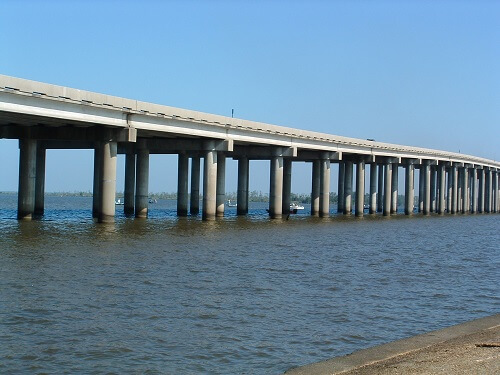Bridges are necessary to avoid physical obstacles while not closing the way beneath like a body of water, valley, or road. It is constructed for providing passage over the obstacle. Among many kinds of bridges, Beam Bridge is significant to make a road over the water for transportation. Let’s go into detail about a beam bridge.
What is Beam Bridge?
A bridge could be a construction that's designed to hide a road, valley, waterbody, or alternative natural obstacles to providing a route over the barrier. Many bridge styles are used that depend on the soil conditions of the location for bridge construction. Among them, beam bridges are the oldest and simplest bridge style consisting of vertical piers and horizontal beams - e.g. simply an easy plank or stone block. They comprise vertical piers and horizontal beams. A beam bridge’s strength depends on the strength of the route and multiplies by adding extra piers. Whereas beam bridges are quite long, the span, or distance between adjacent piers, is typically small.
Read More Articles on Bridges:
- What is a Bridge? Main Parts & Types of Bridges
- Advantages and Disadvantages of Beam Bridges
- What is Arch Bridge? Types of Arch Bridges
Examples of Beam Bridges
- Manchac Swamp Bridge: Span: 36,690 m (120,374 feet). Location: Louisiana, USA.
- Feiyunjiang Bridge: Span: 2,956 m (9,698 feet). Location: Ruian Shi, Wenzhou Shi, Zhejiang Sheng, China


What are Beam Bridges Made of?
Beam bridges are easy and fabricated from wood beams. A bridge crane employing a beam clamp to carry the beams carries serious beams. The bridge load rating is dead to ascertain the hundreds, which will be safely carried by the beam bridges. It is essential to calculate the bending moments in an exceedingly beam to ascertain a secure style of the beam bridges. However, the main elements of Beam Bridge are:
- Wood
- Stone
- Concrete and Steel
- Advanced materials
{adselite}
Weight & Strength of Beam Bridge
Bream Bridges’ weight and strength are depending on the distance that means length, width, and height. However, Beam Bridge’s strength is influenced by the space between the piers. Therefore, the beam bridges are unremarkably not appropriate for an extended length, unless many such bridges are connected.
The beam bridge's span relies upon the beam weight and therefore the strength of the fabric. because the bridge material thickens, its capability to carry the loads will increase. Therefore, the span might even be increased. However, a durable beam might become too serious, and sag. The beam bridges will be supported by the use of trusses.
Types of Beam Bridge
Beam Bridge can be classified into many types based on four main criteria. They are as follows:
- Based on geometry
- Straight beam
- Curved beam
- Tapered beam
- Based on the shape of the cross-section:
- I-beam
- T-beam
- C-beam
- Based on equilibrium conditions:
- Statically determinate beam
- Statically indeterminate beam
- Based on the type of support:
- Simply supported beam
- Cantilever beam
- Overhanging beam
- Continuous beam
- Fixed beam
Brief descriptions of these types of beam bridges are given below:
Classification Based on the Geometry
Straight Beam
A straight beam is one the meets the required criteria. If the nominative beam is specified as straight at intervals .010 inches and therefore the one that you simply are gazing at meets that criteria it is straight.
Curved beam
The stress in a curved flexural member is determined by using the following assumptions.
- The cross-section has an axis of symmetry in a plane along the length of the beam.
- Plane cross-sections remain plane after bending
- The modulus of elasticity is the same in tension as in compression
Tapered beam
A tapered beam subjected to a tip-bending load will be analyzed to predict the distributions of stress and displacement in the beam.
Classification Based on the Shape of the Cross-section
I-beam
I-beams are economical and easy to fabricate. They are merely beaming with an I-shaped or H-shaped cross-sectional. The horizontal components of the "I" style are flanges and therefore the vertical is that the net of the development.
T-beam
This type of beam is usually made monolithically with a reinforced concrete block. Sometimes, an Isolated T-beam is built to extend the compression strength of concrete. else thereto, inverted T-beam may also be made in keeping with the necessities of loading obligatory.
C-beam
C-Beam is known as Channel Beam. Channel beam can be any shape, e.g. U-beam, L-Bean, etc. Channel beam can be made of concrete, steel, and heavy wood. Mainly, channel beams are constructed in the huge building and large brides. The channel-beam bridges are necessary for the load-carrying action.
Based on Equilibrium Conditions
Statically determinate beam
Here equilibrium conditions alone will be accustomed to solving reactions.
Statically indeterminate beam
Here equilibrium conditions do not seem to be enough to resolve reactions. extra deflections are required to resolve reactions.
Based on the Type of Support
Simply supported beam
A merely supported beam is stapled support at one finish and roller support at the opposite finish. It depends on the load applied, that undergoes sharing and mixing. This can be the best, structural components alive.
Cantilever beam
A cantilever beam is mounted at one finish and free at the opposite finish.
Overhanging beam
An overhanging beam has one or each part extending on the far side of its supports. It is any variety of supports. It seems as if it's the feature of the merely supported beam and cantilever beam
Continuous beam
A continuous beam has quite two supports distributed throughout its length.
Fixed beam
Fixed may be a sort of beam whose each end is mounted.

